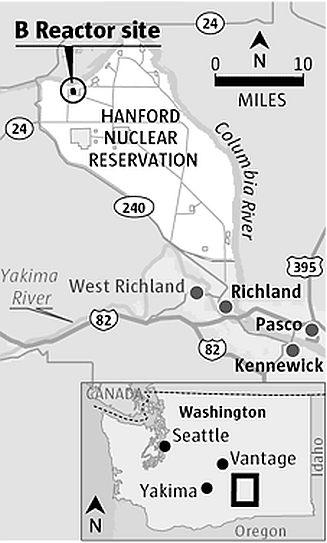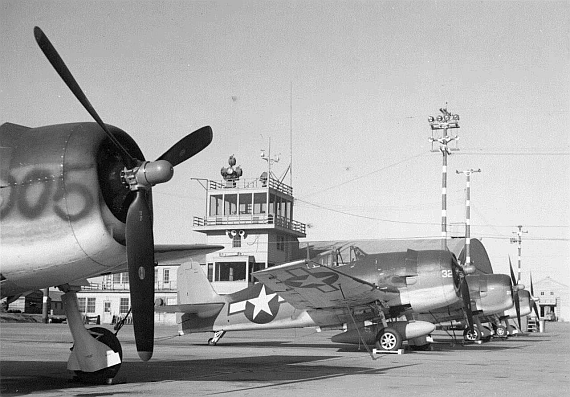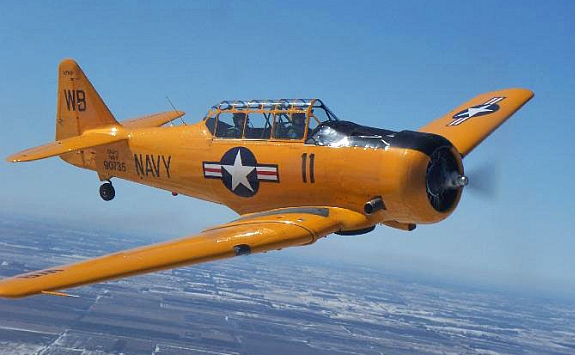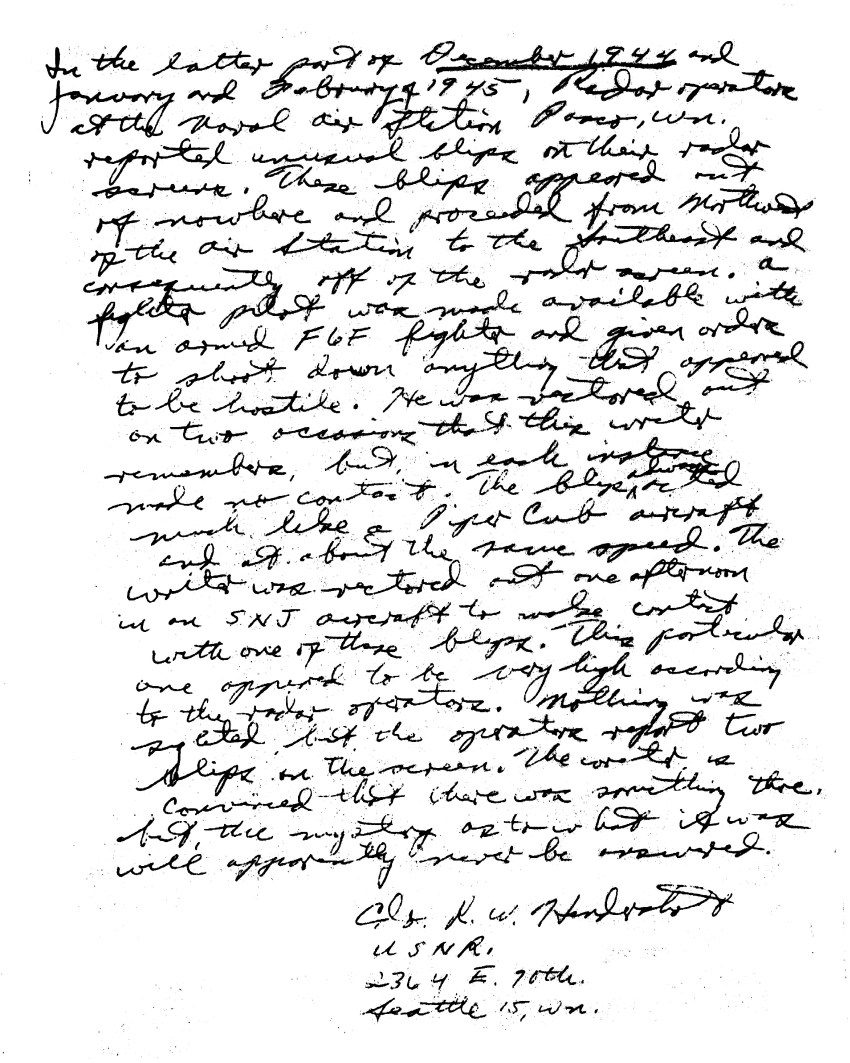In the latter part of December 1944 and January and February 1945,
radar operators at the Naval Air Station, Pasco, Washington,
reported unusual blips on their radar screens. These blips
appeared out of nowhere and proceeded from Northwest of the Air
Station to the Southeast and consequently off of the radar screens.
A fighter pilot was made available with an armed F6F fighter and
given orders to shoot down anything that appeared to be hostile. He
was vectored out on two occasions that this writer remembers, but,
in each instance made no contact. The blip always acted much like
a Piper Cub aircraft and at about the same speed. The writer was
vectored out one afternoon in an SNJ aircraft to make contact with
one of these blips. This particular one appeared to be very high
according to the radar operators. Nothing was sighted but the
operators reported two blips on the screen. The writer is
convinced that there was something there, but, the mystery as to
what it was will apparently never be answered.
Cdr R.W. Hendershot
U S N R
|
Further confirmation of the Hanford aerial intrusions and emergency
installation of radar coverage of the facility came from Colonel Franklin T.
Matthias, Officer in Charge of the Hanford Engineering Works.
One day after the atom bomb was dropped on Hiroshima, Colonel Matthias
convened a press conference to reveal the previously Top Secret activities
undertaken at Hanford.
The Seattle Times carried the report of the conference by Times Associate Editor, Ross Cunningham. In an article published on August 8, 1945, it was publically revealed that there had been suspected aerial intrusions over Hanford, that radar was hastily
installed to detect such intrusions, and that an arrangement was
made with the Navy to intercept the intruders. This confirms that
the plans described within the 4th Air Force documents were
actually carried out, supporting the testimony of the Naval officers
Hendershot, Clem, and Powell regarding encounters by Naval aircraft with intruders
over Hanford. (see Hanford entry in Naval Chronology.)
Excerpt from the Seattle Times article:
“Throughout the war, the project has had no direct protection
against external enemy action, no anti-aircraft, no protective
troops, and no aircraft.” Colonel Matthias explained that radar
was installed at the project hurriedly, “when we saw or thought we
saw unidentified aircraft operating.” Defensive plans, not to be
confused with internal security, rested on an arrangement with the
Navy to send fighter planes if needed and arrangement with the 9th
Service Command to “send us all the troops they had if we needed
them.”
Seattle, Washington, The Seattle Times - 8 August, 1945
Hanford Made Material For Atomic Bomb That Hit Japs
By ROSS CUNNINGHAM
Associate Editor, The Times
HANFORD ENGINEER WORKS, Benton County, Aug. 8.—Stripping away
another layer of the security secrecy shrouding this project, the
Army took newsmen on an inspection of some of the hitherto
restricted areas today after the project head, Col. F. T. Matthias,
in a remarkably frank interview, made these revelations regarding
atomic energy production and use:
1. The atomic material for the bomb which launched the
“finish Japan” attack Sunday was produced in this project.
2. The Hanford project and its principal counterpart in
Tennessee operate independently and if either were closed down the
other could produce the material, although by a divergent process.
3. No plans have been made for the peacetime use of the
Hanford Engineer Works.
4. It is probable that preliminary studies are under way for
adapting atomic energy to peacetime use, but no work along that line
is under way here.
5. Commercial representation is present on the top-flight committee
studying the potentialities of the energy so that the greatest good
possible may be accomplished.
After these statements by the Army officer here in the position to
project the future of atomic energy, newsmen made the 30-mile
drive north from Richland to the center of the production area,
where the “ghost town” of Hanford lies virtually empty.

The newsmen stared at huge cement plants with smokestacks towering
against the sky as workmen within them spin the dials to produce
atomic energy to press forward the attack on Japan. They were not
permitted within the plants, which are within wire inclosures and
Colonel Matthias explained it thus:
“The disclosure of the nature of their work and its effect upon the
enemy has had a stimulating effect and we must get on with
production. It was a terrific relief to the staff to learn the
details and they are proceeding, I’m sure, with renewed zip.
“Besides,” he added, referring to the decision not to allow internal plant
inspection, “these men are working with delicately balanced force and
I don’t think there should be anything to distract them.”
Colonel Matthias' press conference — in which he stood for an hour on a
raised platform behind a counter, snapping a cigarette lighter but never
getting around to lighting his smoke — covered a wide range of subjects,
even including the question as to whether the colonel’s experience with
atomic energy led him to conclude a projectile could be made of it in the
United States and shot to any place on earth.
The colonel smiled, snapped the lighter a couple of times,
and replied slowly:
“We have nothing to lead us to believe it could be done with any
degree of certainty.”
Good nature was applied by the colonel when someone quipped about how
he kept from revealing the secret while “talking in his sleep.”
“I don’t talk in my sleep — and my wife was just as surprised as any one
when she learned Monday what we had been working on,” the colonel smiled.
But the more serious questions were answered in rapid-fire order,
the gray-haired colonel seldom avoiding an answer, and then only
when security was involved, or the top committee in the East had
ruled that the subject was not to be discussed.
Why Hanford Was Chosen
After discussing how the present Hanford site was selected because
of the availability of huge quantities of electrical power, an
abundance of pure water, isolation and cheap land, Colonel Matthias
said that the late President Roosevelt was in close touch with the
project from the beginning, as was Secretary of War Stimson.
President Roosevelt wanted to visit the project but decided against
it because it would focus too much attention on it. The Truman
Senate investigating committee, too, withheld visiting Hanford,
the colonel said, for the same reason.
“The then Senator Truman probably had some inkling of it through
Secretary Stimson.”
Reluctance to emphasize the project also prevented it from beginning with
a triple-A priority for materials, he said, and work was begun with a
third-rate priority. It later was raised when the pinch of materials
threatened to slow construction and it was possible to increase the
priority without emphasizing the project.
Actually, Colonel Matthias said, he didn’t know the exact nature of the
project when he and two other officers selected the site.
“We had only an approximate idea,” he explained.
“We knew that we had to have firm ground for massive buildings,” he said.
These were the towering buildings which newsmen saw from a short distance.
The looming chimneys cast their shadows in points toward the old
construction town of Hanford, where row on row of Quonset huts;
large square dormitories which once housed tens of thousands of men
and women; the commissary which once fed thousands of the employes (sic),
and the research and administrative buildings spread over scores of
acres.
No Workers to Remove Town
Officers explained that they were left standing for two reasons.
Construction changes might at any time up until a few weeks ago have
necessitated their being used again to house more workers. The
second reason was the reluctance to divert essential manpower to
their demolition, although much of the critical electrical
materials have been stripped of(f) and shipped to the South Pacific.
To get on with Colonel Matthias' revelations, he spoke of the
independence of the Hanford and Oak Ridge, Tenn., plants in
response to a question.
“Could the material for the atomic bomb be produced in either Oak Ridge or Hanford?”
“Yes, all of the essential materials,” the colonel replied, adding that
the processes employed in the two projects differs.
“Have you had any trouble with sabotage-spies?”
“The word spies needs defining — but I can say that when the project was in
its early stages we had some people here who were here to try to find out
something.”
“And I can add with certainty we haven’t any now,” Colonel Matthias said
with emphasis.
“You know, when some of them applied and found they had to have their
fingerprints taken before they came to work they didn’t show up again.
Low Rate of Injury
“The project,” he said, “had a low rate of injury among workmen,
and only 16 of the thousands of men and women who worked on the
project were injured fatally — 11 in two accidents, the collapse of
a big tank and a train-wreck.
“It''s unusual but we are not eligible for the E award given by the
Army and Navy,” the colonel said. “We’re too far along — 90 per
cent — with the construction to win a construction award and not far
enough along to get an award through comparison with other plants.
“Throughout the war, the project has had no direct protection
against external enemy action — no anti-aircraft; no protective troops and no
aircraft.”
Colonel Matthias explained that radar was installed at the project
hurriedly, “when we saw or thought we saw unidentified aircraft
operating.” Defensive plans, not to be confused with internal
security, rested in an arrangement with the Navy to send fighter
planes if needed and arrangement with the 9th Service Command to
“send us all the troops they had if we needed them.”
“Do you see any peacetime use of the plant?” he was asked.
“Well, they used to say that there was no future for the horseless
carriage, but you know what happened,” he laughed. “I can't answer that
question and I don’t think anyone else can because no one knows.
“The project was not built with the idea of being part of any projected
Columbia River development.”
He said that the project was a round-the-clock operation, meaning that
it is like an aluminum plant in necessity of continuous operation,
which brought out that for a time there was an outside chance electrical
power interruption by an accident might break off production. But precautions
have been completed now to insure against this.
Other Atoms May Be Used
“I cannot over-emphasize the importance to the nation of security on this
project,” he said.
“On the committee working with the future of the process there are
commercial interests because it is hoped that it can be handled to the
best interest of the country.”
Colonel Matthias said that it is common belief that atoms other than
of U-235 uranium — which is used in the present process — can be utilized as
research progresses.
“I did not think that the public could so quickly realize the importance of
the development of atomic energy,” Colonel Matthias replied in response to a
question as to whether it was being over-emphasized.
“I think it is the biggest thing that has happened in many years.”
“The project was financed at first from President Roosevelt's special fund
to exploit war production,” Colonel Matthias said. “But later the funds
were obtained from a regular congressional appropriation. This involved
letting key members of the appropriations committees know of the
importance of the development, but the key secret was withheld.”




